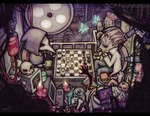
scp-1123
SCP-1123 is an inanimate object from the mythos of the SCP Foundation website. Its debut story, SCP-1123 — Atrocity Skull, was posted in 2012 by science-fiction writer S. Andrew Swann.
SCP-1123 is a human skull lacking the lower jaw with writing made in blood on the forehead/squama frontalis bone. The writing made in Khmer text (នឹកឃើញ nukkheunh, "remember") has physically faded, yet appears more vibrant and freshly painted to a viewer the closer they are to SCP-1123. If a person comes into contact with SCP-1123, they will instantly enter a dissocative fugue state lasting ninety minutes to six hours.
Fugue states induced by SCP-1123 are characterized by confusion, disorientation, and most anomalously, the adoption of a new identity and memories (or "imprint") which consist of knowledge, including language, previously unknown to the subject. Specifically, the imprinted will obtain the life experience of a person who died before they born that suffered torture and a brutal death as a result of a political persecution or other movement, often sanctioned or complicit by a government. No connection between the origin of the imprinting personality and the identity of the imprinted-upon subject based on age, genealogy, gender, ethnicity, or national origin, but the former will invariably have died sometime before the latter was born.
The commonality of historical events appears to correlate with the related death toll, with the imprints of victims of the Holocaust (1941–1945; 17.1-19.6 million) and the Great Chinese Famine (1959–1961; 15–55 million) being more common than from victims of the Armenian genocide (1915–1917; 600,000–1.5 million), Holodomor (1932–1933; 3.5–5 million), or al-Anfal campaign (1988; 50,000–100,000). Experiences have included memories of events that have occurred following SCP-1123's discovery.
Due to the sudden experiences instilled by SCP-1123, subjects will develop psychological effects common to the types of trauma remembered; grief, survivor's guilt, and depression are typical symptoms, yet suicidal ideation has been observed in a few rare instances. Use of amnestics to treat these symptoms has not shown any psychological benefit, instead often proving further harm to subjects' mental health.
SCP-1123 was discovered sometime between 1980 and 1988, after the Cambodian genocide (1975–1979; 1.5–2 million), when a colonel from the People's Army of Vietnam found it among an inventory of human remains intended for a museum documenting the atrocity; the object was intercepted by the SCP Foundation during military transport to Hanoi, Vietnam. SCP-1123 is contained at Site-19 as a Safe-class anomaly, kept hermetically sealed in a humid, room-temperature, argon-filled case to preserve its integrity.
Other S. Andrew Swann creations
- Moreau Quadrilogy
External Links
Posts (view all)
